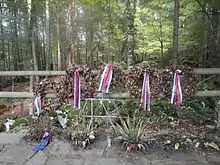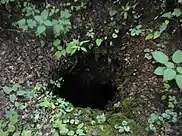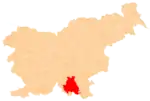Onek
Onek (pronounced [ˈoːnɛk]; German: Hohenegg,[2][3] Gottscheerish: Wrneggə[4]) is a settlement in the hills east of Kočevje in southern Slovenia. The area is part of the traditional region of Lower Carniola and is now included in the Southeast Slovenia Statistical Region.[5]
Onek | |
|---|---|
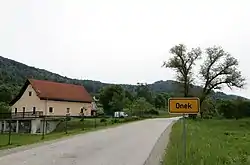 | |
 Onek Location in Slovenia | |
| Coordinates: 45°37′32.72″N 14°56′37.26″E | |
| Country | |
| Traditional region | Lower Carniola |
| Statistical region | Southeast Slovenia |
| Municipality | Kočevje |
| Area | |
| • Total | 15.66 km2 (6.05 sq mi) |
| Elevation | 585.1 m (1,919.6 ft) |
| Population (2002) | |
| • Total | 31 |
| [1] | |
Name
The Slovene name Onek is derived from German Hohenegg. The German name Hohenegg and the Gottscheerish name Wrneggə are derived from hohen Eck 'high hillside, high slope',[4] with the common southern German reflex -egg (< Old High German ekka),[6] thus referring to a local geographical feature.
History
Onek was a village settled by Gottschee Germans. In the land register of 1574, Onek is listed as having eight full farms that were subdivided into 16 half-farms,[7] corresponding to a population between 90 and 100.[4] The 1770 census recorded 29 houses in the village.[4] A school was established in the village in 1884.[8][9] In 1936 there were 37 houses in the village and a population of 140.[9] There was substantial emigration from the village before the Second World War. At that time, its economy was based on agriculture, peddling, and the sale of timber and firewood.[9] Its original population was evicted in November 1941. In the summer of 1942 Italian troops burned the area. After the Second World War the village was resettled by Slovenes from Prekmurje.[7]
Mass graves
Onek is the site of two known mass graves from the period immediately after the Second World War. The Kren Cave Mass Grave (Slovene: Grobišče Jama pod Krenom) is located north of Onek in a sinkhole measuring 26 meters (85 ft) across and 7 meters (23 ft) deep. It contains the remains of soldiers from the Croatian Armed Forces, Serbians, and probably also Germans and Russian Cossacks transported from the prisons at Šentvid and Kočevje.[10] The Debelič Meadow near Kren Cave Mass Grave (Grobišče Debliške livade pri Jami pod Krenom) is located about 20 meters (66 ft) behind the sign for the Kren Cave Mass Grave, 10 meters (33 ft) below the road, in the direction of the Rog Sawmill. It contains the remains of soldiers that were unable to walk to Kren Cave from the point to which they were transported by truck.[11] A series of roadside wooden sculptures several meters high representing the Stations of the Cross, created by Stane Jarm (1931–2011) in 1998, mark the route to the graves from nearby Željne.[12]
Religious heritage
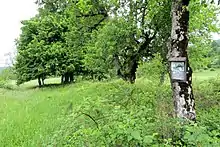
A 17th-century chapel dedicated to Saints Cosmas and Damian formerly stood at a fork in the road north of Onek.[13] The year 1662 (or perhaps 1862) was carved into a roof beam of the chapel. The keystone of the door casing was carved with the inscription IHS 1817 and the letters GIGK, probably indicating that it was renovated in 1817, the same year that the new Saint Anne's Church was built in neighboring Mačkovec.[14][15] The chapel had a square nave and a polygonal chancel walled on three sides with a shingled gabled roof. On the ridge of the roof there was a wooden bell tower with a square hip roof. According to the Slovenian Cultural Heritage Registry, the chapel was burned during the Second World War;[13] however, according to Ferenc, it was in good condition after the war and only the interior furnishings were damaged. Masses were held in the chapel immediately after the war, and then it was used to store hay.[14][15] The chapel was demolished in 1955, and its site is registered as cultural heritage.[13]
A church dedicated to Saint Anne stood above the village, in the territory of what is now Mačkovec.[9] It was demolished in 1965.[7]
References
- Statistical Office of the Republic of Slovenia
- Leksikon občin kraljestev in dežel zastopanih v državnem zboru, vol. 6: Kranjsko. 1906. Vienna: C. Kr. Dvorna in Državna Tiskarna, p. 40.
- Ferenc, Mitja. 2007. Nekdanji nemški jezikovni otok na kočevskem. Kočevje: Pokrajinski muzej, p. 4.
- Petschauer, Erich. 1980. "Die Gottscheer Siedlungen – Ortsnamenverzeichnis." In Das Jahrhundertbuch der Gottscheer (pp. 181–197). Klagenfurt: Leustik.
- Kočevje municipal site
- Heintze, Albert. 1882. Die Deutschen Familiennamen: Geschichtlich, geographisch, sprachlich. Halle: Buchh. d. Waisenhauses, p. 129.
- Savnik, Roman, ed. 1971. Krajevni leksikon Slovenije, vol. 2. Ljubljana: Državna založba Slovenije, p. 235.
- Kundegraber, Maria. 1991. "Die deutsche Sprachinsel Gottschee im 19. Jahrhundert." Etnolog. Nova vrsta 1:82–120, p. 87. (in German)
- Krajevni leksikon Dravske Banovine. 1937. Ljubljana: Zveza za tujski promet za Slovenijo, p. 216.
- Ferenc, Mitja (December 2009). "Grobišče Jama pod Krenom". Geopedia (in Slovenian). Ljubljana: Služba za vojna grobišča, Ministrstvo za delo, družino in socialne zadeve. Retrieved October 15, 2023.
- Ferenc, Mitja (December 2009). "Grobišče Debliške livade pri Jami pod Krenom". Geopedia (in Slovenian). Ljubljana: Služba za vojna grobišča, Ministrstvo za delo, družino in socialne zadeve. Retrieved October 15, 2023.
- Fajfar, Stane. 1998. Križev pot Slovencev. Osilniška dolina 14: 6.
- Slovenian Ministry of Culture register of national heritage reference number ešd 2791
- Ferenc, Mitja, & Gojko Zupan. 2012. Izgubljene kočevske vasi, vol. 2 (K–P). Ljubljana: Znanstvena založba Filozofske fakultete Univerze v Ljubljani, p. 192.
- Ferenc, Mitja. Onek: Kapela sv. Kozme in Damijana / Hohenegg: Kapelle St. Kosma und Damian (in Slovene and German)
External links
 Media related to Onek at Wikimedia Commons
Media related to Onek at Wikimedia Commons- Onek on Geopedia
- Pre–World War II map of Onek with oeconyms and family names
